
Best Places in Tibet to Go for Meditation
For many people from around the world, Tibet is one of the most ideal places to be for practicing meditation, as this vast and desolate landscape promotes a natural sense of well-being and calm, and the Tibetan Buddhist religion of the plateau can help travelers to induce and reach that state of peace that comes with meditative practice.
Tibetan monks and lamas spend much of their lives in meditation, and it is widely known that the ancient Buddhist sages such as Milarepa and Padmasambhava spent many years in meditation caves and sanctuaries in their quests for enlightenment. With such a vast area of the plateau to choose from there are a huge number of places where you can travel to find that perfect place to meditate and reach a calm state of mind, many of which are easily reachable on our amazing Tibet tours.
Go for Mediation in Lhasa and its Surroundings
One of the most spiritual cities in the world, Lhasa is the center of Tibetan Buddhism and the spiritual heart of Tibet. An area of the TAR with a huge number of monasteries and temples, holy and sacred lakes, and some of the most auspicious mountains on the plateau, Lhasa is one of the best places in Tibet for meditation and revitalizing that spiritual energy.
Drak Yerpa Monastery
There are few places like the meditation caves at Drak Yerpa hermitage in Dazi County of Lhasa for a little meditative contemplation. Located around 16km to the northeast of Lhasa, this site was once one of the holiest cave retreats in Tibet, and was attended by such Buddhist sages as Padmasambhava and Atisha, as well as being popular with the Tibetan king, Songtsen Gampo, whose Tibetan wife established the first chapel on the site in the 7th century. Caves dot the entire lower face of the cliffs, and there are different practices that are done in several of the caves by pilgrims visiting the site. It is said that there are exactly 108 caves at the site, an auspicious number in Tibetan Buddhism, which is one of the reasons the site is sacred.
 Drak Yerpa Monastery, the holiest caves for meditation in Lhasa
Drak Yerpa Monastery, the holiest caves for meditation in Lhasa
Caves are not the only place to meditate at Drak Yerpa, though. Sitting on the hillside overlooking the beautiful Lhasa Valley, the hermitage Lhakhang faces some of the most stunning countryside in Tibet. Looking out over the lush green valley, with its small shrub bushes dotting the hillsides, is a relaxing sight in itself.
Pabonka Hermitage
Located around eight kilometers to the north of Lhasa Old City, the Pabonka Fort was originally built on a huge stone that vaguely resembles a turtle. An ancient Hermitage that predates the sacred Jokhang Temple and the fort that once stood on the site of the Potala Palace, the hermitage is one of the oldest buildings in Tibet. It is said that the fort that once stood there, which was destroyed during the rule of Langdharma, stood nine stories high and was the site where the first Tibetan words were written in stone, and where seven sons of noble birth became the first Tibetan Buddhist monks. - Check the meditation trips in Tibet.
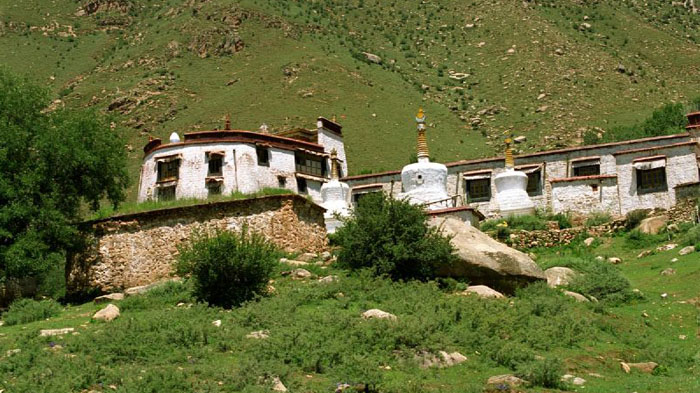 Pabonka Hermitage was an ancient royal palace founded by the 7th century Tibetan King, Songtsen Gampo.
Pabonka Hermitage was an ancient royal palace founded by the 7th century Tibetan King, Songtsen Gampo.
The site is isolated in the area, sitting atop its turtle-rock, and is peaceful and serene with few tourists. While the hermitage is a wonderful place for peaceful contemplation, the hillside behind this remote hermitage is just as peaceful, and looks out over the beauty of the Lhasa Valley.
Turquoise Yamdrok Lake
What better sight can you imagine when meditating in Tibet than the beauty of one of the Great Three Sacred lakes of Tibet? Lake Yamdrok, with its turquoise waters, is one of the most amazing places on the plateau, and lying close to Lhasa, is an ideal place to travel to for a little relaxing contemplation of oneself. One of the more popular ways to practice meditation is to have something of great beauty in your eyes, so that your mind sees the beauty of the world, not the evil, and there are few places like Lake Yamdrok for outstanding natural beauty. With a vast area and immense shoreline, there are more places than you could imagine spending a few hours meditating on the lakeside.
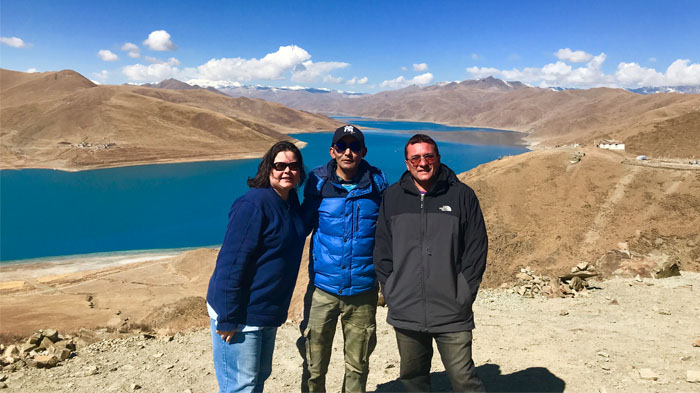 Turquoise Yamdrok Lake is also a popular place for meditating in Tibet..
Turquoise Yamdrok Lake is also a popular place for meditating in Tibet..
Pristine Namtso Lake
Lake Namtso, to the north of Lhasa in Damxung County, has more reasons for meditating there than almost anywhere else in Tibet. Not only do you have the Tashi Dor Island, with its monastery and meditation caves at the side of the lake, but the temple there has its own kora route around the island, not to mention the stunning beauty of the lake itself. Another of the Great Three, this beautiful lake is a sight to behold and a place of peace and solitude ideal for deeper meditation. Find out whether you should visit Yamdrok Lake or Namtso Lake.
 Having a mediation along the riverside of holy Namtso Lake.
Having a mediation along the riverside of holy Namtso Lake.
Go for Mediation in Shannan, Birthplace of Tibetan Buddhism
Shannan Prefecture, also known in Tibet as Lhoka, is believed to be the birthplace of the Tibetan civilization, and is the origin of meditative practice in Tibet, which dates back to the earliest days of Buddhism in the region. This ancient land that is renowned for having the first temple and palace in Tibet is a great place to spend some time in meditative contemplation.
Samye Monastery
The first Buddhist monastery in Tibet, Samye Gompa was built to revitalize Buddhism in the empire, and is located in Dranang in Lhoka. The site is auspicious in Tibetan Buddhism, as it was the place where the Buddhist master Padmasambhava performed the sacred dance to rid the area of a local malevolent spirit, binding it to be the protector of Buddhism in Tibet. The monastery is built around a model of the universe, with the main hall representing Mount Meru, and the outer temples representing the oceans, continents, and other features in Buddhist cosmology. The monastery is also renowned for being the location of the Sacred Tree, a popular site for pilgrimage on which is placed stones and threads by pilgrims and meditators.
 Turning the prayer wheel in Samye Monastery
Turning the prayer wheel in Samye Monastery
Chim-puk Hermitage
A collection of cave shrines that lies to the northeast of the Samye Monastery, Chim-puk Hermitage is built around the meditation site of Guru Rinpoche, who spent several years in the caves there meditating and teaching. It is known that the Tantric practitioners of the caves were once famed for their protection of the fields and harvests from the storms of the region. The site contains dozens of meditation caves that can be found across the hillside, and even the hillside itself, which looks out over the beautiful valley below, is a great and quiet place for meditating.
 Chim-puk Hermitage is a warren of caves northeast of Samye.
Chim-puk Hermitage is a warren of caves northeast of Samye.
Go for Mediation in Shigatse, Home to Panchen Lamas
Home to the Tashilhunpo Monastery and the Panchen Lamas, the second highest incarnation in Tibetan Buddhism, Shigatse is an unexpected place to be meditating, but has an awesome place for a little contemplative reflection.
Tashilhunpo Monastery
Built in the 15th century by the first Dalai Lama, Tashilhunpo Monastery is the home of the Panchen Lama, which means “Great Scholar” in Tibetan. The monastery itself is renowned for being an ideal place for meditation, and has a huge number of halls and chapels that are perfect for contemplation. From the awesome 5-storey Maitreya Hall where the Future Buddha is enshrined, to the dozens of chanting halls where faithful monks chant the scriptures all day long, this amazing monastery has plenty of places to sit in meditation for a few minutes to reflect on the beauty of the world.
 Exploring Tashilhunpo Monastery with friends during Tibet tour
Exploring Tashilhunpo Monastery with friends during Tibet tour
Go for Meditation in Everest Region
Few people believe that you can head out to Mount Everest for a little meditative practice, but heading to EBC also means heading for the Rongbuk Monastery, the highest Buddhist monastery in the world and the location of one of the most remote meditation caves in the region.
Rongbuk Monastery
Sitting pretty at an altitude of 4,980 meters above sea level, this high monastery sits on the location of several ancient meditation caves, which can be found in the hillside behind the monastery. With their perfect views of the highest mountain peak in the world, these small caves make a great place to meditate. However, the best place for meditation is the meditation cave that lies under the monastery itself, stretching out under the base camp. A surreal and out-of-this-world experience, the cave has been used by the abbots of the monastery since it was built in 1902, and before that was a hermitage for Buddhist nuns and a pilgrimage site for Sherpas.
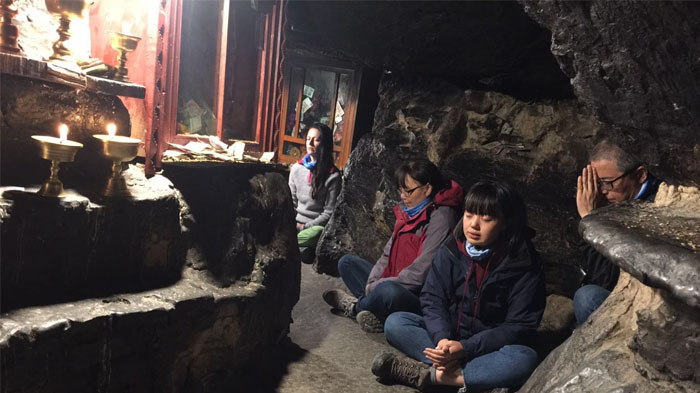 Our clients were doing meduation in meditation cave of Rongbuk Monastery.
Our clients were doing meduation in meditation cave of Rongbuk Monastery.
Go for Meditation at Mt.Kailash and Manasarovar in Western Tibet
In the far west of Tibet, in Ngari Prefecture, lie two of the most sacred sites in the world, one mountain and one lake. Mount Kailash and Lake Manasarovar are classed as the most sacred sites of their kind in Buddhism and Hinduism, and are amazing sites to see as well as great places for meditation.
Holy Mt.Kailash
As the most sacred mountain in the world in Buddhism and Hinduis, Mount Kailash is the ideal place to go for meditation. A serene and spiritual mountain, this huge pyramid of black rock is believed to be the earthly representation of the legendary Mount Meru, and has five monasteries around its base. Any of these monasteries makes a good place to meditate, and if you can make the trek around the mountain, you can also sit on the crest of the Dolma La Pass at more than five thousands meters and meditate with one of the most amazing views on the planet in front of you.
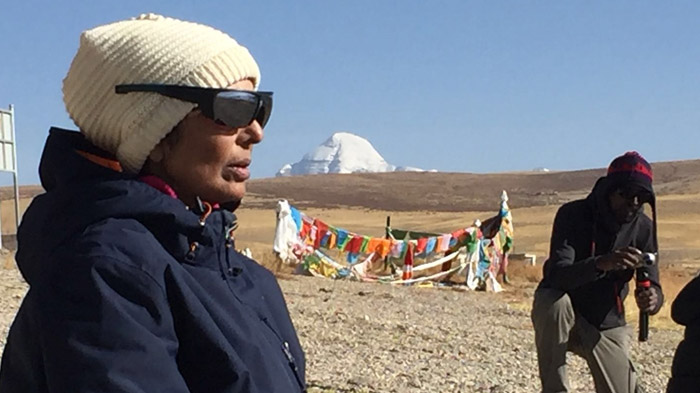 Mt.Kailash, the ideal place to go for meditation in Tibet.
Mt.Kailash, the ideal place to go for meditation in Tibet.
Sacred Manasarovar Lake
Lake Manasarovar, which lies to the south of Mount Kailash, is one of the Great Three Sacred Lakes of Tibet, and is often considered to be the most revered in both Hinduism and Buddhism. Believed to be the place where Maya Devi conceived Siddhartha Gautama, who later became the Sakyamuni Buddha, this stunning lake is believed to be the embodiment of purity, and both Buddhists and Hindus believe that to drink of or bathe in the waters will absolve you of the sins of an entire lifetime. The quiet shores of the lake, which see few tourists throughout most of the year, are an ideal place for meditation, with the serenity of the place and the stillness of its sweet fresh waters. There are five temples that are also dotted around the lake, each of which is located in an auspicious location according to Tibetan Buddhism, and which all make good sites to meditate in peace.
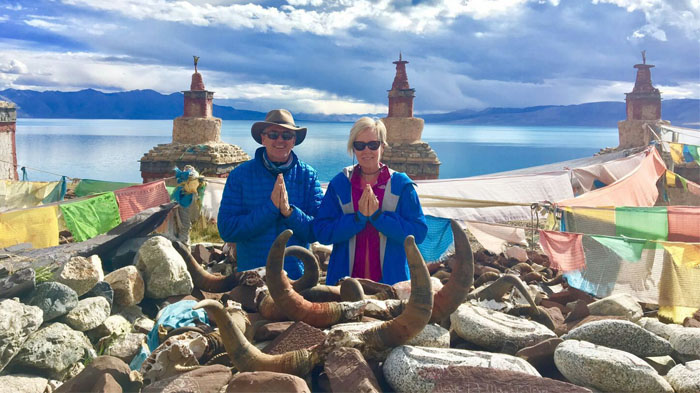 Our clients were worship at the sacred Manasarovar Lake.
Our clients were worship at the sacred Manasarovar Lake.
What to Prepare for the Mediation Trip in Tibet
Before taking a trip to Tibet to meditate I the sacred sites around the plateau, you will need to book a pre-arranged tour with a registered Tibetan tour operator. This is required as
independent travel is not permitted in Tibet. You will also need to have the required permits for the area to which you are visiting, and each of the major areas around the region has a different permit, which means that for some you will need all of the permits for the region. The documents you will need for a trip to Tibet for meditation include:
Chinese Entry Visa - All travelers to Tibet from mainland China are required to have a Chinese Entry Visa in advance of their trip in order to secure other permits and passes that are needed for the trip. Only tourists entering from Nepal will not need to have their visa in advance, as it is obtained once you arrive in Nepal.
Tibet Travel Permit - This is required for entry to Tibet and to travel around in the area of Lhasa. The permit is obtained using scanned copies of your passport and Chinese Entry Visa.
The following travel formalities will be prepared by our Tibetan guide after you finish your visit in Lhasa.
Alien’s Travel Permit - Required for travel to the “unopened” areas of Tibet outside Lhasa, including Shigatse.
Restricted Areas Permit - This is often called the “Military Permit”, and is required for travel to military-sensitive areas such as Ngari, Nyingchi, etc.
Frontier Pass - While most tours will not actually cross the border out of China, the Frontier Pass is required for all tourists traveling in the areas of the Chinese border with India, Nepal, and Bhutan, which includes Mount Everest and Mount Kailash.
Conclusion
Tibet is the ideal place to travel to for a meditating trip due to the huge spiritual essence of the plateau region. One of the most devout Buddhist locations in the world, few places can match this plateau land when it comes to spirituality and meditation. One of the main techniques for understanding yourself and attaining enlightenment, meditation is practiced by almost all of the people of Tibet, not just the monks and lamas. So if you want to find somewhere peaceful and spiritual to practice your sublime meditation, or you are just learning and want to know more about meditation practices and how they can even help in your daily life, then there is nowhere as good as Tibet, the Roof of the World.

I am a tour guide in Tibet an was Born in Kham Tibet, I am the father of 2 little girls, bachelor's degree. I have more than 7-years experience of being a tour guide in Tibet. I am a warm, friendly, knowledgeable and attractive guy.


.jpg)


0 Comment ON "Best Places in Tibet to Go for Meditation"